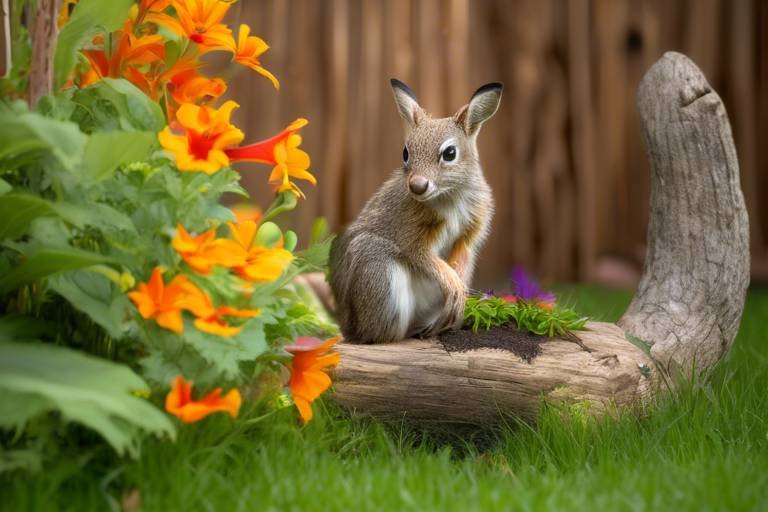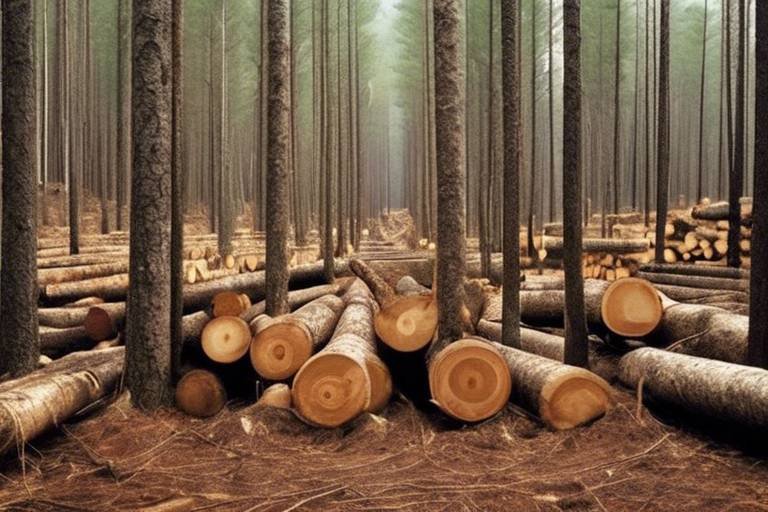10 Ways to Create a Wildlife-Friendly Backyard
Creating a wildlife-friendly backyard is not only beneficial for the environment but also a rewarding experience for any nature lover. By following these ten simple yet effective tips, you can transform your outdoor space into a thriving ecosystem that supports local wildlife and biodiversity.
First and foremost, planting native species is crucial in attracting local wildlife to your backyard. Native plants provide food and shelter for various animals, birds, and insects, creating a sustainable and diverse ecosystem right outside your door.
In addition to plants, it's essential to provide water sources for wildlife. Consider adding birdbaths, ponds, or even a small dish of water to ensure that animals have access to hydration, especially during hot summer months.
Installing bird feeders is another effective way to attract a variety of bird species to your backyard. Choose the right feeders and seeds to cater to different birds' dietary needs and enjoy the beauty of these feathered visitors.
Creating shelter and nesting sites is vital for wildlife to feel safe and secure in your backyard. From birdhouses to insect hotels, providing various nesting options will encourage animals to make your garden their home.
Avoiding the use of chemical pesticides is crucial for the well-being of wildlife. These harmful substances can have detrimental effects on animals and insects, so opt for natural alternatives to maintain a healthy backyard ecosystem.
By creating habitat layers in your backyard, such as trees, shrubs, and ground cover, you can support a diverse range of wildlife. Each layer offers different resources and habitats for various species, enhancing the overall biodiversity of your garden.
Offering nesting materials like twigs, leaves, and grass can help birds and other wildlife build their homes comfortably. Simple additions like these can make a significant difference in attracting and supporting nesting animals.
Limiting lawn mowing frequency can benefit wildlife by providing food sources and shelter. Allowing certain areas of your lawn to grow wild can create valuable habitats for insects, small mammals, and birds.

Plant Native Species
Discover how to transform your outdoor space into a haven for local wildlife with these simple and effective tips.
When it comes to attracting local wildlife to your backyard, planting native species is key. Native plants are adapted to the local climate and soil conditions, making them more attractive to birds, insects, and other wildlife. By choosing native species, you are not only providing food and shelter for local wildlife but also contributing to the overall biodiversity of your area.
Native plants have evolved alongside local wildlife, forming crucial relationships that support the ecosystem. These plants offer nectar, pollen, seeds, and fruits that are essential for the survival of many species. Additionally, native plants require less maintenance, as they are naturally suited to the environment, reducing the need for excessive watering, fertilizers, and pesticides.
Creating a diverse landscape with a variety of native plants will attract a wide range of wildlife, from butterflies and bees to birds and small mammals. Consider planting a mix of flowers, shrubs, and trees to provide different levels of habitat and food sources. By mimicking the natural habitats found in your region, you can create a wildlife-friendly backyard that benefits both the local ecosystem and your enjoyment of nature.
Furthermore, native plants are more resilient to local pests and diseases, reducing the need for chemical interventions that can harm wildlife. By planting native species, you are promoting a healthy and balanced environment that supports the interconnected web of life in your backyard.

Provide Water Sources
When creating a wildlife-friendly backyard, one essential element to consider is providing adequate water sources for the local fauna. Water is crucial for hydration, bathing, and even breeding for various wildlife species. By incorporating water features into your outdoor space, you can attract a diverse range of animals and support their well-being.
One simple way to provide water sources is by installing a birdbath. A birdbath not only offers birds a place to drink and bathe but also attracts other creatures like butterflies and bees. Ensure the birdbath is shallow with a gradual slope for easy access and change the water regularly to prevent mosquito breeding.
For a more natural approach, consider adding a small pond or water garden to your backyard. Ponds can support a variety of wildlife, including frogs, dragonflies, and aquatic plants. Incorporating rocks and plants around the pond can create hiding spots for animals and add aesthetic value to your outdoor space.
If space is limited, even a simple dish of water can make a difference. Placing shallow dishes or trays filled with water around your yard can provide hydration for small animals like squirrels, rabbits, and insects. Remember to keep the water fresh and clean to attract wildlife without posing health risks.
By offering different water sources, you can not only attract wildlife to your backyard but also create a thriving ecosystem where animals can find refuge and sustenance. Whether it's a birdbath, pond, or a humble water dish, providing water sources is a vital step in making your outdoor space wildlife-friendly.

Install Bird Feeders
Installing bird feeders in your backyard can be a simple yet effective way to attract a diverse array of bird species. By providing a reliable source of food, you can create a welcoming environment for our feathered friends to visit regularly. When choosing bird feeders, consider the types of birds you want to attract and the seeds they prefer. Different bird species have varying feeding habits, so offering a variety of feeder styles and seed options can help cater to a wider range of birds.
Positioning your bird feeders strategically can also enhance their appeal to birds. Placing feeders near trees or shrubs can provide perching spots and shelter for birds to rest while they feed. Ensure that the feeders are easily accessible and visible to birds, but also consider placing them in locations that offer some protection from predators. Regularly cleaning and refilling the feeders is essential to maintain a healthy feeding environment and prevent the spread of diseases among birds.
Observing the behavior of birds around your feeders can be a rewarding experience, allowing you to learn more about their feeding preferences and interactions. You may even attract unexpected visitors like squirrels or chipmunks, adding an element of surprise and excitement to your backyard wildlife encounters. Remember, the goal of installing bird feeders is not just to feed the birds but also to create a harmonious ecosystem where humans and wildlife can coexist peacefully.

Build Shelter and Nesting Sites
Creating shelter and nesting sites in your backyard is crucial for providing a safe haven for wildlife to thrive. Imagine your backyard as a bustling city, with each plant and structure serving as a high-rise building or cozy home for different species. By incorporating various shelters and nesting sites, you can attract a diverse range of wildlife and contribute to the overall biodiversity of your outdoor space.
One effective way to build shelter is by planting dense shrubs and bushes that offer protection from predators and harsh weather conditions. These plants can act as natural hideouts for birds, small mammals, and insects, providing them with a secure place to rest and raise their young. Additionally, consider installing birdhouses or bat boxes to offer specific nesting sites for these creatures, encouraging them to stay and reproduce in your backyard.
When designing your shelter and nesting sites, think about the different needs of wildlife species. Some birds prefer open nesting areas, while others seek out secluded spots. By providing a variety of options, such as bird boxes, dense foliage, and even rock piles, you can cater to the nesting preferences of a wide range of wildlife.
Furthermore, incorporating natural materials like branches, leaves, and grass clippings into your backyard can offer additional nesting resources for birds and other creatures. These materials can be used by wildlife to construct their nests, creating a cozy and secure environment for raising their offspring.
Remember, the goal of building shelter and nesting sites is to mimic the natural habitats that wildlife rely on for survival. By carefully planning and implementing these features in your backyard, you can transform your outdoor space into a welcoming sanctuary for a variety of species, fostering a harmonious coexistence between humans and wildlife.

Avoid Chemical Pesticides
When it comes to creating a wildlife-friendly backyard, one crucial step is to at all costs. These harmful substances not only pose a threat to the targeted pests but also have detrimental effects on the overall ecosystem of your outdoor space. Chemical pesticides can contaminate water sources, harm beneficial insects, and even poison birds and other wildlife that come into contact with them.
Instead of resorting to chemical pesticides, consider natural alternatives that can effectively manage pests without causing harm to the environment. For example, introducing predator insects like ladybugs or lacewings can help control pest populations naturally. Additionally, planting certain herbs and flowers like marigolds or lavender can act as natural repellents for common garden pests.
Another way to avoid chemical pesticides is by encouraging natural predators in your backyard. Birds, bats, and certain insects like praying mantises are all-natural predators that can help keep pest populations in check. By creating a welcoming environment for these beneficial creatures, you can maintain a healthy balance in your backyard ecosystem without the need for harmful chemicals.
Furthermore, practicing good garden hygiene can also reduce the need for chemical pesticides. Removing weeds promptly, regularly cleaning up fallen fruits, and maintaining proper plant spacing can help prevent pest infestations and promote the overall health of your garden. By keeping your backyard clean and well-maintained, you can minimize the risk of pest problems without relying on chemical interventions.

Create Habitat Layers
Creating habitat layers in your backyard is like building a high-rise condominium for wildlife. Just like humans, animals have different preferences when it comes to where they live. By incorporating various layers such as tall trees, shrubs, and ground cover, you are providing a diverse range of habitats for different species to thrive.
Imagine your backyard as a bustling city where each layer serves a different purpose. The tall trees act as skyscrapers, offering nesting sites and protection for birds like owls and hawks. Shrubs and bushes function as mid-rise buildings, providing cover and food sources for smaller mammals and insects.
Ground cover, like a lush green carpet, creates a welcoming environment for amphibians, reptiles, and insects. By incorporating these layers, you are essentially creating a mini ecosystem that can support a variety of wildlife in your own backyard.
Additionally, these habitat layers not only attract wildlife but also contribute to the overall health of your outdoor space. Trees and shrubs help improve air quality, reduce soil erosion, and create a more visually appealing landscape. It's a win-win situation for both you and the local wildlife!

Provide Nesting Materials
When it comes to creating a wildlife-friendly backyard, providing nesting materials is a crucial aspect that often gets overlooked. Birds and other wildlife rely on these materials to build their homes and raise their young, making it essential to include in your backyard habitat planning.
One way to provide nesting materials is by setting up a designated area where birds can easily access twigs, leaves, and grass. You can create a small corner in your yard or hang a basket filled with these materials to offer a convenient resource for nesting birds.
Additionally, consider planting native plants that naturally shed twigs, leaves, and other materials that wildlife can use for nesting. Trees like oak and maple, as well as shrubs like dogwood and elderberry, are great options that provide both shelter and nesting materials for birds.
By incorporating a variety of textures and sizes in the nesting materials you offer, you can attract a diverse range of bird species to your backyard. Different birds have different preferences when it comes to building their nests, so providing a selection of materials can cater to various nesting needs.
Remember, the goal is to create a welcoming environment where wildlife feels safe and supported in raising their young. By offering nesting materials, you are not only enhancing the biodiversity of your backyard but also contributing to the overall health of the local ecosystem.

Limit Lawn Mowing
Discover how to transform your outdoor space into a haven for local wildlife with these simple and effective tips.
When it comes to creating a wildlife-friendly backyard, one surprising tip is to limit lawn mowing. While a neatly trimmed lawn may look appealing to us, it can actually be detrimental to wildlife. By reducing the frequency of mowing, you allow wildflowers and grasses to grow, providing essential food sources and shelter for insects, birds, and small mammals. These areas can also serve as nesting sites for various wildlife species, contributing to a more biodiverse ecosystem in your backyard.
Frequently Asked Questions
- What are the benefits of creating a wildlife-friendly backyard?
Creating a wildlife-friendly backyard has numerous benefits, such as attracting beautiful birds, butterflies, and beneficial insects to your outdoor space. It also helps in promoting biodiversity, supporting the local ecosystem, and creating a peaceful and harmonious environment right at your doorstep.
- How can I attract more birds to my backyard?
To attract more birds, you can install bird feeders with a variety of seeds, provide fresh water sources like birdbaths, and plant native trees and shrubs that offer food and shelter. Additionally, creating nesting sites and offering nesting materials will make your backyard a welcoming habitat for our feathered friends.
- Why is it important to avoid chemical pesticides in a wildlife-friendly backyard?
Chemical pesticides can harm not only the pests they target but also beneficial insects, birds, and other wildlife. By avoiding these harmful chemicals and opting for natural pest control methods, you can protect the delicate balance of your backyard ecosystem and ensure the health and well-being of your local wildlife.
- How can I create habitat layers in my backyard?
To create habitat layers, you can plant a mix of trees, shrubs, and ground cover plants to provide different levels of vegetation for various wildlife species. Trees offer shelter and nesting sites for birds, while shrubs provide food sources and cover. Ground cover plants attract insects and small mammals, completing the diverse habitat in your backyard.
- What are some simple ways to provide nesting materials for wildlife?
You can offer nesting materials by leaving out twigs, leaves, grass clippings, and even pet fur in your backyard. These materials are essential for birds and other wildlife to build their nests and raise their young. By providing these nesting resources, you are helping to support the breeding success and population growth of local wildlife.



















